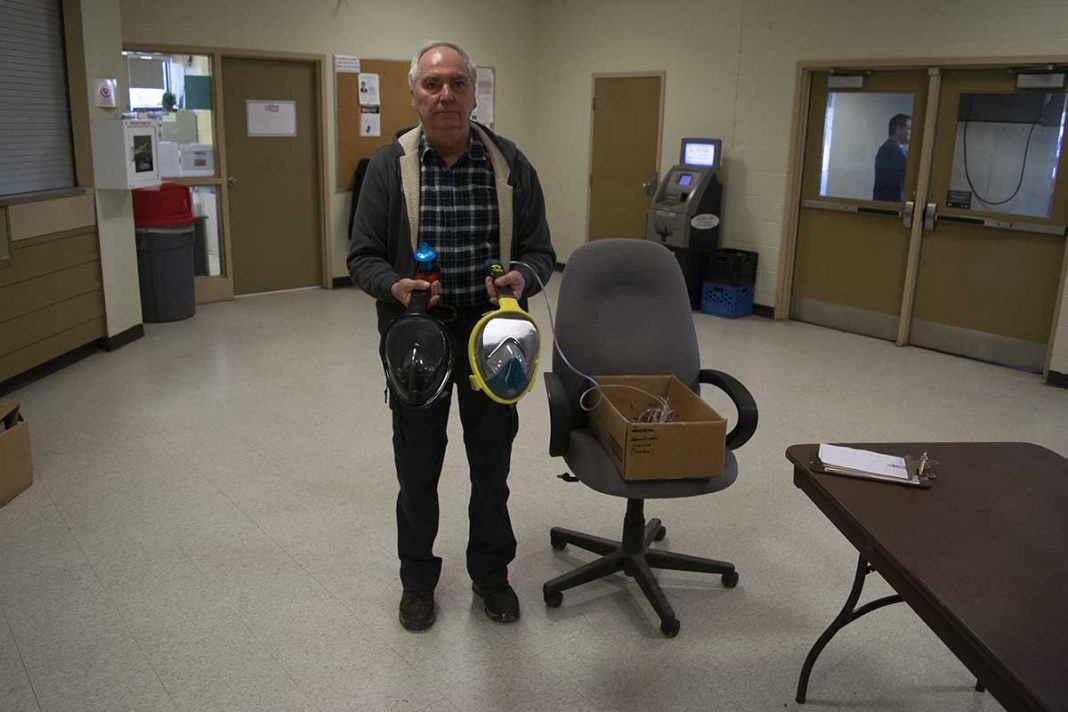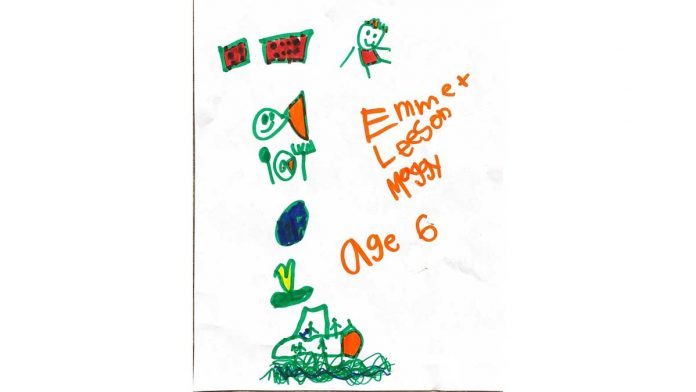LITTLE CURRENT – Retired paramedic Bill Cranston of Mindemoya has created a novel method of delivering oxygen to COVID-19 patients while also potentially reducing the exhalation of viral droplets and airborne particles using an ordinary object with a series of one-way seals—a full-face snorkel mask.
Mr. Cranston is a member of both the emergency committee and the patient advisory committee at Manitoulin Health Centre (MHC). He has been spending considerable time in his modest home workshop in recent months to help find solutions to make Manitoulin Island better prepared to fight the coronavirus.
“Dr. (Mike) Bedard is a personal friend of mine and we have been talking about this since mid-January and building ideas since then,” said Mr. Cranston.
“(Mr. Cranston) can silicone in an oxygen tube and this rigidity provides PEEP—positive end-expiratory pressure (which refers to the pressure left in the lungs after breathing out) and he also, on the exhale, put a (bacterial and viral) filter. It’s pretty cool, I think,” said Dr. Bedard, the president of the medical staff at MHC who has also offered to be the lead physician at the hospital’s temporary sub-acute care centre (SCC) which is set up at the Little Current-Howland Recreation Centre.
The base for these contraptions is a full-face snorkel mask. The entire face area is enclosed and there are separate internal chambers for mouth/nose and the remainder of the face. A built-in snorkel extends out of the top of the mask to a top-mounted intake.
“The advantage of this is it’s all a one-way system. There’s three one-way valves in here,” said Mr. Cranston.
Just as purpose-built oxygen masks have reservoirs between the oxygen supply and the patient, so too do these masks. Oxygen is brought in through the snorkel, stored in a reservoir around the eyes and inhaled through a one-way valve into a chamber around the mouth and nose. Exhaust air is exhaled through another one-way valve out the front of the mask.
It is important to note that the snorkel mask technique has not been tested for its efficacy, nor has it been approved by Health Canada. However, given the unprecedented circumstances, Dr. Bedard said it was a lot better than nothing.
Dr. Bedard said the masks could also be useful for care staff because the same ‘barrierbac’ filter that would be put on patients’ exhalation valves could be attached to the air intake. Since it is at the top of the snorkel tube, all incoming air for the physician would be up and away from the patient’s face.
Dr. Bedard and Mr. Cranston believe hospital staff could also wear N95 respirator masks underneath the snorkel mask as an extra layer of protection. Mr. Cranston experimented with wearing an old surgical mask under the snorkel setup and said it still performed as designed.
Using the modified snorkel masks will hopefully extend the lifespan of personal protective equipment such as N95 masks. Last week, MHC emergency preparedness committee representative Dr. Maurianne Reade issued a call for physicians to save their N95s in biohazard bags pending the possible implementation of sterilizing techniques.
Each of the replaceable barrierbac filters can be used for 24 hours and are easy to change once their useful life has expired. Because the masks themselves are designed for snorkelling, they can be submerged in a tub of soapy water and scrubbed to kill the virus.
Mr. Cranston said he was still investigating whether or not the masks could be sanitized using UV light or whether it would harm the plastic, but he suspected that the masks’ intended purpose of outdoor snorkelling would likely mean they use UV-safe plastic.
A spin-off benefit of the snorkel mask setup is that it prevents the wearer from accidentally touching their face, which is one of the main ways the virus is presently known to enter one’s body.
One issue Mr. Cranston was still working on at the time of his brief demonstration was creating a good seal for mask users with glasses. For users without glasses, though, Mr. Cranston demonstrated the natural tight seal of the mask. With his assistant Dr. Bedard plugging the intake hole, no air could be heard seeping through and the mask was suctioned tightly to Mr. Cranston’s face.
Those leading the Manitoulin Island COVID-19 effort have placed an order for 40 snorkel masks which will be retrofitted for use if and when traditional oxygen delivery options cannot keep up with demand.




